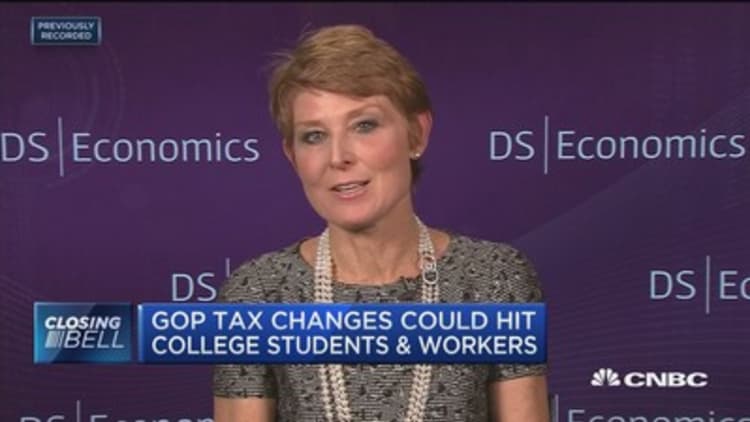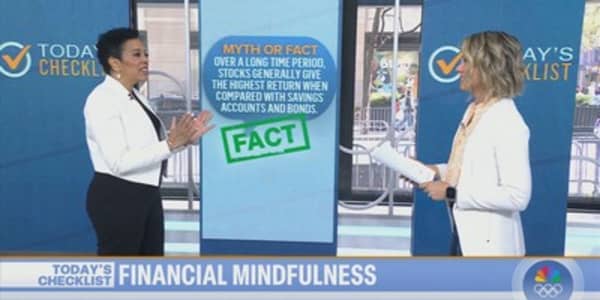At the Johns Hopkins Bloomberg School of Public Health in Baltimore, Nick Rizzutti spends his days researching how different environments affect the health of children.
To get there, he racked up more than $80,000 in student debt.
So Rizzutti, 28, was relieved to find out that he qualifies for Public Service Loan Forgiveness. That program, signed into law by President George W. Bush in 2007, allows certain members of the military, classroom teachers and social workers, as well as not-for-profit and government employees, to have certain loans eliminated after 10 years of on-time payments.
Just the thought that I might not get forgiveness is scary. I'd be making payments for 30 years. It would delay my life.Nick RizzuttiStudent loan borrower
Unfortunately, after a year of chipping away at his student debt, Rizzutti learned during a phone call with a financial aid officer that not all loans are eligible for forgiveness — and some of his loans did not qualify.
Just like that, he was back at square one.
"It was disappointing," said Rizzutti, who immediately moved his various loans into a direct consolidation loan, which does qualify for forgiveness.
But the experience left him on edge.
"Just the thought that I might not get forgiveness is scary," Rizzutti said. "I'd be making payments for 30 years. It would delay my life."
As it turns out, plenty of people in public service jobs — some two-thirds of whom make less than $50,000 a year — believe they're paying their way to loan forgiveness yet actually don't qualify for one technical reason or another.

Each year, more than 30 percent of people who file a so-called Employee Certification Form, which is supposed to confirm one's public service loan forgiveness status, are denied, according to the Department of Education. And this form is not mandatory for public service loan forgiveness, and so the total number of people denied is probably greater.
These problems are so common that the Consumer Financial Protection Bureau issued a report in June on the failures of the student loan industry to properly inform people about forgiveness requirements and rights.
"Borrowers have identified a range of student loan industry practices that delay, defer, or deny access to expected debt relief," according to the report.
Since the DOE first began accepting requests in October 2017, some 16,000 people have applied, a DOE spokesman told CNBC.
But fewer than 1,000 people are expected to be eligible.
Jay Fleischman, a student loan lawyer, said he's heard from people who were almost done with that decade of repayment when they first learned that none of those payments counted toward forgiveness.
"They call me up because they want me to help guide them through getting finalized," he said. "And I'm the one who has to be the bearer of bad news: They're going to have to start from scratch.
"I have people cry on the phone," Fleischman added.
It's imperative that people who believe they might qualify for forgiveness act fast to make sure they're doing everything right, said Miranda Marquit, a financial expert at Student Loan Hero, a website for managing debt.
"A lot of time you don't realize there's a problem until you actually apply for loan forgiveness," she said.
Here's how to make sure you're on — and staying on — the right path.
1) Make sure you have the right loans
Like many former students, Rizzutti had different kinds of loans. His Federal Family Education Loan (FFEL) and his Perkins Loan did not qualify for loan forgiveness.
That's because only "direct loans" — which include direct subsidized and unsubsidized loans, direct PLUS loans and direct consolidation loans — are eligible under the program. (Other loan forgiveness programs have their own rules.)
I'm the one who has to be the bearer of bad news: They're going to have to start from scratch.Jay Fleischmanstudent loan lawyer
Check to see if you can bundle your nonqualifying loans into a Direct Consolidation Loan. (Most federal loans are eligible; private student loans are not.) Only when your loans are under this title will your student debt payments move you along the Public Student Loan Forgiveness 10-year timeline.
If you already have some direct loans you've made forgiveness-qualifying payments on, you might not want to consolidate those with the nonqualifying loans into one new debt. That restarts the clock on forgiveness.
Not sure what kind of loans you have? Check your account at the Department of Education's Federal Student Aid site to find out.
2) Repaying correctly?
You also need to make sure that you're enrolled in the right type of repayment plan; for Public Student Loan Forgiveness, specifically, one of the income-based programs.
Make sure you don't have a repayment plan that doesn't count toward forgiveness, such as an extended repayment plan.
But there might be some wiggle room on this requirement.
The Department of Education has issued directions for some student loan borrowers who work in public service jobs to reapply for a second chance at debt relief if they were denied because of their repayment plan.
To apply for the $350 million fix-it fund, you still need to have made the 120 qualifying and on-time payments under the program and have already been rejected for public service loan forgiveness.
3) Check that your employer qualifies
Qualifying employers under the Public Student Loan Forgiveness program include government organizations (federal, state, local or tribal), not-for-profit organizations that are tax-exempt under Section 501(c)(3) and some other not-for-profits that provide public service.
AmeriCorps and Peace Corps volunteers also count as qualifying employment.
Although you must work full time to be eligible, you can work part time for say, two qualifying employers, as long as you're working more than 30 hours a week in total.
Your time with a qualifying employer doesn't need to be consecutive. You can work for two years at a qualifying not-for-profit, for example, and then pause your 10-year timeline to work for two years in the private sector. If you resume employment at a qualifying employer, the clock toward forgiveness will start ticking again.
4) Confirm that you're on track
Every year you should fill out the Employment Certification Form.
Once this form is submitted, all of your loans will be transferred to Fed Loan Servicing, the designated loan company for the Public Service Loan Forgiveness Program. Each year, you will receive confirmation on the number of successful payments you've completed.
But even with filling out that form, Fleischman said, he has still seen things go wrong. He advises people to keep a paper trail of their work history and any communication they have with their student loan provider.
"If there's a problem down the road, and you've thrown out your pay stubs, you have nothing to rely on," he said.
5) Watch for new developments
Students just starting to think about loan forgiveness have one more thing to worry about.
In December, Rep. Virginia Foxx, R-N.C., chairwoman of the House Committee on Education and the Workforce, proposed a bill that would greatly reduce the Public Service Loan Forgiveness Program by further narrowing eligibility.
And the program would disappear entirely in President Donald Trump's spending proposal.
"It removes the incentive to take a job that doesn't pay as much, but is in the public good," Marquit said. "It might encourage more people to go into the private sector."
More from Personal Finance:
Bitcoin, once 'sketchy,' becomes more mainstream
Some cryptocurrency-backed debit cards dropped from Visa network, leaving users scrambling
Bitcoin is too risky to treat as a 'serious' investment, financial advisers say






